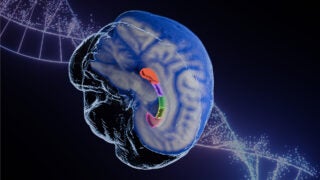
Robert Yoshida punches the bag in one of his weekly boxing classes. (Photo/Glenn Marzano)
Shorter strides, faster walking, regular falls: the difficulties of dealing with Parkinson’s
With physical therapy — and weekly boxing classes — one man found the footing to hold off his mental and physical decline because of the neurological disease
A little more than a decade after being diagnosed with Parkinson’s disease, Robert Yoshida started to experience a change in his manner of walking.
The result of increased tension in the muscles, the condition changes the way patients with Parkinson’s walk, making their stride much shorter and their speed more rapid. In Yoshida’s case, he was also unable to control the direction he was walking and could not stop unless he ran into something or fell.
As a result, he began to experience regular falls, which made it impossible for him to continue his job as a financial analyst. Only 50 at the time, Yoshida’s quality of life took a major hit.
“I would lean forward and run, and I could not control it,” he said. “I didn’t leave the house much because of it.”
The condition is known as festination. Rather than put up with it, Yoshida sought help from a physical therapist. A neurologist at Keck Medicine of USC had suggested he contact Erin Caudill, a faculty member at the USC Division of Biokinesiology and Physical Therapy who specializes in working with patients with neurological conditions.
When Yoshida first met Caudill, adjunct instructor of clinical physical therapy, his condition was so severe that it was putting him in danger.
He was walking so fast, he was almost running and he was falling a lot, which can lead to serious injuries.
Eric Caudill
“He was walking so fast, he was almost running and he was falling a lot, which can lead to serious injuries,” said Caudill, who runs a private physical therapy practice in Westchester.
Caudill noted that physical therapy can be extremely beneficial for patients with a broad range of neurological disorders, including stroke and traumatic brain injuries. But the specialty is still relatively young, and not all neurologists are aware that their patients would be better served by working with a physical therapist who specializes in patients with neurological disorders, she explained.
Physical therapy can help
With respect to patients with Parkinson’s in particular, Caudill noted that groundbreaking research being done by Keck Medicine of USC neurologists has changed the way Parkinson’s patients are treated.
They now know, for example, that Parkinson’s patients should do vigorous, high-intensity workouts and that their program needs to involve both aerobic and skill-based exercise for maximum benefit.
By maximum benefit, Caudill doesn’t just mean they should only experience improvements in muscle control, balance, posture and their overall endurance. Experts now know that Parkinson’s patients — if given the right type of physical therapy — will not only experience changes in their bodies and muscles but also in their brains.
“This is a way to promote better blow flow to the brain, which promotes better use of dopamine,” Caudill said, adding that many patients reduce their medication if they stay with physical therapy. “With the right program, people can get better and not worse, and Parkinson’s patients can make improvements even years after the onset of their disease.”
Stepping into the ring
Yoshida’s treatment involves at least two sessions a week. One is a high-intensity exercise class aimed at helping participants improve the most common challenges for patients with Parkinson’s — balance, posture and endurance. The other is a one-on-one boxing class taught by USC physical therapy alumna Jacki Nash.
Nash said that while vigorous, high-intensity workouts may have proven positive effects, there is little research on whether boxing benefits Parkinson’s patients. But she believed that many of the types of movements that are taught in a boxing class are those that are known to help address Parkinson’s symptoms.
“There is a lot of rotating, which helps with rigidity, which can be a big challenge for people with Parkinson’s,” she said.
Boxing also forces participants to do two skills at once. They have to follow precise stepping patterns while practicing specific types of hits, like jabs and hooks, with their arms at the same time. Those types of moves require intense focus for many individuals with Parkinson’s who not only struggle with balance and strength but also in reacting to commands to move certain ways.
Yoshida was one of Caudill’s first patients to sign up for boxing. Initially, he struggled — both with performing the moves and with developing the strength to hit hard.
“Now I feel like I am moving fluidly when I box,” Yoshida said. Nash added that he has become a “powerhouse hitter.”
Since starting physical therapy with Caudill, Yoshida said he’s been able to reduce his medication and has even seen improvements in many of his symptoms.
“I am standing better, and my balance and strength is better,” Yoshida said, noting that he can now control the direction he walks and rarely falls anymore.
“I have found that I really enjoy boxing and I am pretty good at it,” Yoshida said. “There are a lot of frustrations with Parkinson’s, and boxing is a good way for me to get those frustrations out.”



